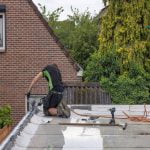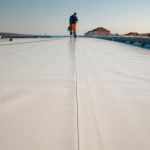Seeing as a roof is the core aspect of any building project, to deliver the best results for homeowners or clients, felt roofers must keep up with the industry, which has significantly evolved over time.
One noticeable shift in typical roofing practices has been moving away from the heavy use of traditional materials like felt. As you might know, felt has been a staple in roofing for decades, mainly due to its affordability.
However, felt notoriously does a poor job of keeping water out, which is the most essential component of any roof. That is why today’s roofers are turning to more modern, advanced alternatives like rubber.
Several more factors are contributing to this trend…
What Roofers Use Instead of Felt

Durability
Homeowners are more knowledgeable than ever about roof types and materials, and a big concern for them is durability and whether their roof material can provide decent enough protection from water intrusion or is prone to deterioration over time. This is especially true if they live in an area that experiences harsh weather conditions, temperature fluctuations, or moisture, which can cause felt to degrade, leading to leaks and other problems.
Alternative roofing materials outperform felt in various aspects
In comparison, modern roofing materials like synthetic underlayment or rubber roofing products like FlexiProof (fleece-backed EPDM or one-piece) are both lightweight, flexible and tear-resistant, making them easier to install and more resilient against damage or the elements. Synthetic rubber materials are less susceptible to mould and mildew growth than traditional felt and enhance the roof’s lifespan. Many felt roofers are making the switch to rubber as a more durable and eco friendly roofing material.
Homeowners of today are more environmentally conscious
It’s not just cost and durability driving homeowners and roofers away from felt. Instead, the modern shift is also down to environmental consciousness. Traditional felt is typically made from bitumen-saturated organic fibres, which poses environmental concerns due to using fossil fuels in construction and runoff pollution.
Advanced but still affordable alternatives like rubber are often manufactured using recycled materials or are, in fact, recyclable themselves. This means they can be reused or repurposed elsewhere, reducing the environmental impact of installing a roof and disposing of it.


Regulatory changes
Building code updates have also influenced the roofing industry’s preferences, as building standards have leaned towards more energy-efficient, sustainable materials.
This has meant that roofers alike have been inclined to adopt their materials to meet and even exceed these requirements. New roofing materials often offer better insulation properties, reduce heating and cooling costs and boost the property’s overall energy efficiency.
Cost-effectiveness
Cost-effectiveness plays a significant role in any roofing project. Explore the costs of a new roof.
In some cases, while traditional felt might offer a lower upfront cost compared to alternative materials, its shorter lifespan and higher maintenance requirements often result in higher long-term expenses to sustain it. Plus, when you look at the cost of materials like rubber here, you’ll see how it can beat the price of felt and offer homeowners a better solution.
Therefore, investing in more durable roofing materials will reduce the need for repairs and replacements, leading to significant savings over time. As the roofing industry continues to evolve, the use of felt will likely decrease, paving the way for more innovative solutions and materials that meet the ever-changing needs of modern construction.












